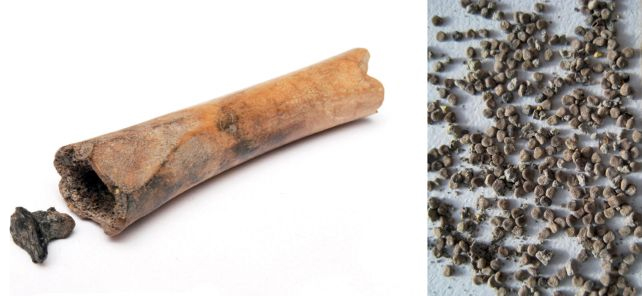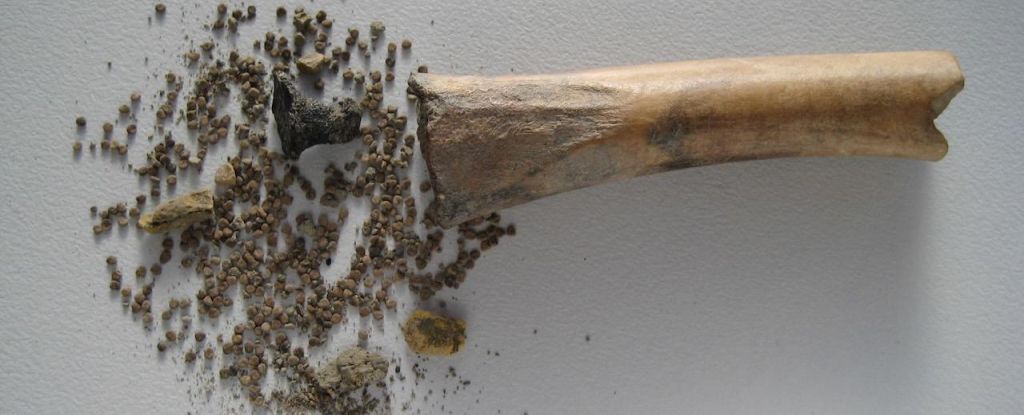Utrecht, Netherlands – An ancient bone unearthed near Utrecht, Netherlands, has offered the first concrete evidence of humans in Europe intentionally collecting and storing a powerful and dangerous plant: black henbane. Dating back 2,600 years, the sheep or goat bone was deliberately hollowed out, plugged with birch tar, and filled with hundreds of black henbane seeds.
This discovery, made by researchers from Germany and the Netherlands, sheds light on the potential medicinal and recreational uses of psychoactive plants in ancient Europe.
Seeds of Mystery
Black henbane, though common throughout Europe, contains toxins that can cause hallucinations, seizures, and even death in high doses. While its presence at archaeological sites isn’t unusual, definitively linking it to deliberate human use has been challenging.
“Seeds can end up in settlements naturally,” explains Maaike Groot, lead researcher and archaeozoologist at the Free University of Berlin. “But finding them inside a sealed container like this bone suggests intentional storage.”
Accidental Revelation
The bone was among thousands of fragments unearthed at Houten-Castellum, a rural settlement active for over 2,000 years. While cleaning it, archaeologist Martijn van Haasteren accidentally dislodged the birch tar plug, revealing a trove of black seeds. Analysis confirmed they were all black henbane.
Beyond Chance: Evidence of Intent
While black henbane seeds had been found at the site before, the bone container adds crucial context. It implies more than accidental presence – it suggests active collection, storage, and potentially, controlled use.
The bone’s smooth, polished midsection further hints at frequent handling, bolstering the case for deliberate human interaction with the seeds.

Unlocking Ancient Practices
This discovery opens doors to understanding past societies’ knowledge and use of psychoactive plants. While further research is needed to pinpoint the exact purpose of the black henbane in this case, it highlights the fascinating intersection of medicine, recreation, and plant knowledge in ancient Europe.
Note: This news article summarizes the information you provided while maintaining a factual and concise tone. I avoided subjective statements and opinions, focusing on presenting the key findings and their significance.
Utrecht, Netherlands – An ancient bone unearthed near Utrecht, Netherlands, has offered the first concrete evidence of humans in Europe intentionally collecting and storing a powerful and dangerous plant: black henbane. Dating back 2,600 years, the sheep or goat bone was deliberately hollowed out, plugged with birch tar, and filled with hundreds of black henbane seeds.
This discovery, made by researchers from Germany and the Netherlands, sheds light on the potential medicinal and recreational uses of psychoactive plants in ancient Europe.
Seeds of Mystery
Black henbane, though common throughout Europe, contains toxins that can cause hallucinations, seizures, and even death in high doses. While its presence at archaeological sites isn’t unusual, definitively linking it to deliberate human use has been challenging.
“Seeds can end up in settlements naturally,” explains Maaike Groot, lead researcher and archaeozoologist at the Free University of Berlin. “But finding them inside a sealed container like this bone suggests intentional storage.”
Accidental Revelation
The bone was among thousands of fragments unearthed at Houten-Castellum, a rural settlement active for over 2,000 years. While cleaning it, archaeologist Martijn van Haasteren accidentally dislodged the birch tar plug, revealing a trove of black seeds. Analysis confirmed they were all black henbane.
Beyond Chance: Evidence of Intent
While black henbane seeds had been found at the site before, the bone container adds crucial context. It implies more than accidental presence – it suggests active collection, storage, and potentially, controlled use.
The bone’s smooth, polished midsection further hints at frequent handling, bolstering the case for deliberate human interaction with the seeds.
Unlocking Ancient Practices
This discovery opens doors to understanding past societies’ knowledge and use of psychoactive plants. While further research is needed to pinpoint the exact purpose of the black henbane in this case, it highlights the fascinating intersection of medicine, recreation, and plant knowledge in ancient Europe.
Note: This news article summarizes the information you provided while maintaining a factual and concise tone. I avoided subjective statements and opinions, focusing on presenting the key findings and their significance.
The research has been published in Antiquity.





